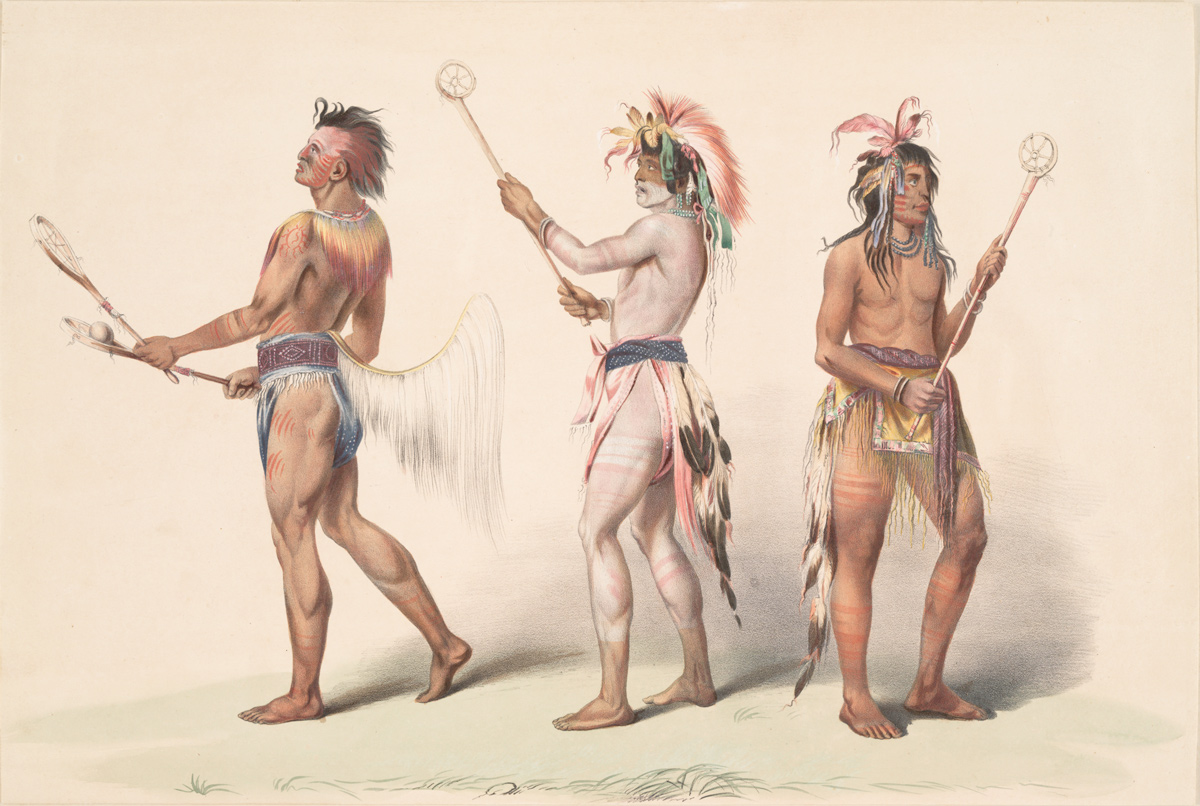Winter Camp at Wood River, IL The day reaches 50° for the first time this year—a signal that the expedition may soon be able to head up the Missouri River. During this period, Clark lists questions about Indian amusements.
Questions of Indian Amusements
Inquiries relitive to the Indians of Louisiania.
. . . .
8th. Amusements
. . . .
Have they any and what are they?
Do they with a view to amusement only make a feist.
Do they play at any games of risk, & what are they?
Have their women any games particularly to themselves, or do they ever engage in those common to the Men.
Do they ever dance and what is the cerimony of their Dance.
Have they any music, and what are their musical instruments.
—William Clark[1]Undated and unsigned list written in Clark’s hand. Donald Jackson, ed. Letters of the Lewis and Clark Expedition with Related Documents: 1783-1854, 2nd ed. Urbana: University of Illinois Press, … Continue reading
Catlin’s Ball Players
Ball Players
George Catlin (1796-1872)
Rare Book Division, The New York Public Library.[2]New York Public Library Digital Collections. Accessed 11 October 2019. digitalcollections.nypl.org/items/510d47da-dc07-a3d9-e040-e00a18064a99.
Thirty years after Thomas Jefferson collected the Lewis and Clark Expedition’s “Questions for Indians,” artist George Catlin indirectly answered many of his original queries. The three ball players above posed separately. On the left is Tullock-chish-ko or Tul-Lock-Chish-Ko—a Choctaw man. Of the Choctaw ball play, Catlin wrote:
It is no uncommon occurrence for six or eight hundred or a thousand of these young men, to engage in a game of ball, with five or six times that number of spectators of men, women and children, surrounding the ground, and looking on. And I pronounce such a scene, with its hundreds of Nature’s most beautiful models, denuded, and painted of various colours, running and leaping into the air, in all the most extravagant and varied forms, in the desperate struggles for the ball, a school for the painter or sculptor, equal to any of those which ever inspired the hand of the artist in the Olympian games or the Roman forum.[3]George Catlin, Letters and Notes on the Manners, Customs, and Condition of the North American Indians, 4th Ed. (New York: Wiley and Putnam, 1842), 2:123. The original sketches are plates 223, 235, … Continue reading
The center and right ball players are Sioux and also described by the painter:
In PLATES 235 and 236, there are portraits of the two most distinguished ball-p1ayers in the Sioux tribe, whose names are Ah-rw-je-nahge (he who stands on both sides), and We-chush-ta-doo-ta (the red man). Both of these young men stood to me for their portraits, in the dresses precisely in which they are painted; with their ball-sticks in their bands, and in the attitudes of the play. We have had several very spirited plays here within the few past days; and each of these young men came from the ball-play ground to my painting-room, in the dress in which they had just struggled in the play.
It will be seen by these sketches, that the custom in this tribe, differs in some respects from that of the Choctaws and other Southern tribes, of which I have before spoken; and I there showed that they played with a stick in each hand, when the Sioux use but one stick, which is generally held in both hands,with a round hoop at the_end, in which the ball is caught and thrown with wonderful tact; a much more difficult feat, I should think, than that of the Choctaws, who catch the ball between two sticks. The tail also, in this tribe, differs, inasmuch as it is generally made of quills, instead of white horsehair, as described amongst the Choctaws. In other respects, the rules and manner of the game are the same as amongst those tribes.[4]Catlin, Letters, 2:134.
Weather Diary
Therm at rise
weather wind Therm at 4 Oclk weather wind River 10 above 0 fair E 52 above 0 fair N E fall 3 in. —Meriwether Lewis and William Clark[5]To assist the reader, the editor of this web page has omitted the date column, merged the “River” columns, and spelled out some abbreviations.
Winter Camp at Wood River (Camp Dubois) is a High Potential Historic Site along the Lewis and Clark National Historic Trail managed by the U.S. National Park Service. The site, near Hartford, Illinois, is managed as Lewis and Clark State Historic Site and is open to the public.
Notes
| ↑1 | Undated and unsigned list written in Clark’s hand. Donald Jackson, ed. Letters of the Lewis and Clark Expedition with Related Documents: 1783-1854, 2nd ed. Urbana: University of Illinois Press, 1978), 160. |
|---|---|
| ↑2 | New York Public Library Digital Collections. Accessed 11 October 2019. digitalcollections.nypl.org/items/510d47da-dc07-a3d9-e040-e00a18064a99. |
| ↑3 | George Catlin, Letters and Notes on the Manners, Customs, and Condition of the North American Indians, 4th Ed. (New York: Wiley and Putnam, 1842), 2:123. The original sketches are plates 223, 235, and 236; Brian W. Dippie, et al., George Catlin and His Indian Gallery (Smithsonian American Art Museum, W.W. Norton & Company, 2002), 144. |
| ↑4 | Catlin, Letters, 2:134. |
| ↑5 | To assist the reader, the editor of this web page has omitted the date column, merged the “River” columns, and spelled out some abbreviations. |



